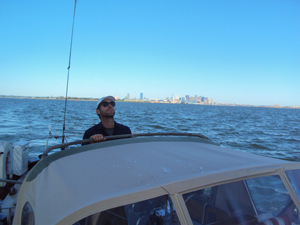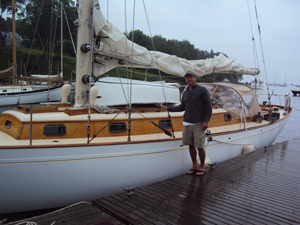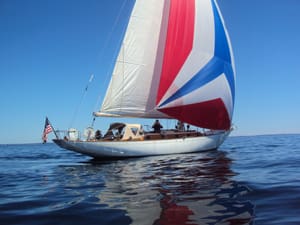To the editor: A few months ago, I received an e-mail that had the effect of jolting me back in time. Would I be interested and available, the note asked, in delivering a 50-foot wooden sloop from Boston to Rockport, Maine? The boat had no propeller and therefore needed to be sailed the whole way, including off her mooring, through the inner harbor, and out the ship channel to sea. One hundred fifty miles later, as I neared the harbor in Rockport, I was to call for a tow for the final approach to the dock.
The boatyard had gotten my name from a mutual friend, who said he had just the person to deliver the boat. Ten years before I had purchased the schooner Bagheera and delivered it from the Eastern Shore of Maryland back to Maine where it had been built in 1924. On that delivery, we enjoyed flawless, early summer weather for the first few days. An uneventful sail from Delaware Bay gave way to moderate winds and quartering seas around Cape May that carried us around Long Island. We were preparing to enter the Cape Cod Canal in preparation for the final leg of the journey, feeling like princes, when the propeller inexplicably spun off the shaft and promptly sank to the bottom of Buzzards Bay. We would eventually complete the delivery, but not before suffering the effects of a terrible stormfront, accepting a tow from the U.S. Coast Guard, and getting a new propeller fitted in Gloucester, Mass. We ultimately limped into Portland, Maine, feeling more like whipped dogs than conquering heroes (see Ocean Navigator, Jan./Feb. 2003, “It’s hard to go home again”).
 |
|
Brian McClellan as Solution clears Boston Harbor. |
Now here I was again facing a similar adventure. An unusual twist was that the owner of the boat, a 50-foot Aage Nielsen sloop named Solution, was a previous owner of Bagheera. What was it with this guy and his apparent connection to boats that lose their propellers, and, more pressingly, why couldn’t I shake him?
While I was intrigued by the challenge, I also had to ask: why not send a diver down and install a propeller? The answer was that the failed propeller was a Luke design, requiring not just a new prop but also pulling the entire shaft. This was a major job, and the owner wanted Rockport Marine to do the delicate work. Delicate, challenging, and just a little strange.
Of course I said yes.
The first trick of any delivery is matching a suitable weather window with the dates you have available in your calendar. First, I called all my old friends from the Bagheera adventure and asked if they were interested in a rematch against a boat without a propeller in the waters off Cape Ann.
The only person from that voyage able to clear his schedule was my old friend Brian McClellan. As an instructor at the Rockland Apprenticeshop, McClellan is a full-time boatbuilder and an expert amateur racer. Having also once sailed with him in the Eggemoggin Reach Regatta, I can well remember how, hour after hour, he continuously fussed with the running rigging to eek a little more speed out of the boat. Sailboat racing, especially in light air, drives me crazy, with its admixture of anxiety and slow motion. But to McClellan, a math major in college, fiddling with the sails was like scratching an itch or solving a pleasantly-frustrating math formula — a constant, pleasurable exercise. I enjoy sailing for the adventure, the natural sights, and camaraderie, making McClellan an ideal companion, both for his gentle, easygoing demeanor and for his attention to making the boat go efficiently. Plus, he’s fantastically tall, and I am not. He can reach high into the rig, deep over the side, way out over the water. And he eats (and enjoys) anything put in front of him, even straight from a can. It’s like sailing with Roald Dahl’s Big Friendly Giant.
The weather forecast called for westerly winds, five to 10 knots, to give way to southwest winds, 10 to 15 knots, in the afternoon. In my mind’s eye, I pictured the mooring field and could imagine no better wind direction for brazenly sailing off a mooring into a ship channel in an unfamiliar boat. It would be early, meaning traffic would be minimal.
We agreed to meet at 0530 at Boston’s Logan International Airport, where Solution’s owner, Carter Bacon, was to pick us up and take us down to Rowes Wharf.
Solution was ideally situated on the outer edge of the moorings. Its white hull, with its graceful overhangs, was a lovely sight in the golden, early-morning sunlight. Bacon took us through a quick overview of the systems — bilge pumps and other safety gear, battery banks, sailing instruments, nav gear, autopilot, and engine. The boat seemed well-equipped and sound. Half an hour later, we shook hands all around; Bacon stepped onto the harbor launch, wished us luck, and waved goodbye.
 |
|
Twain Braden with Solution alongside the dock at Rockport. |
We started the engine to charge batteries, and, while it was useless as propulsion, added placebo-like comfort as we raised the main and jib. With the main flogging and the jib filling alternately to port and starboard, McClellan moved to the foredeck to stand by the mooring pennant. Solution would pick up a tremendous amount of speed, briefly causing panic as we envisioned her dragging her mooring and crashing into the other moored boats, before being drawn up short by the pennant and charging off in the other direction. It was on one of these see-saw maneuvers, the jib backed to port and the bow pointed to open water, that McClellan released the pennant, and we sailed free.
The journey proved as simply blissful as it began. The wind continued through the afternoon, growing light so that we set the asymmetrical spinnaker just south of Cape Ann. By sunset Thacher Island and Cape Ann were out of sight, and we were ghosting along over the northern edges of Stellwagen Bank, a whale sanctuary. The huffs and wheezes of surfacing finback whales, along with the gurgle of the bow wave and the occasional slapping of the sails, were the only sounds. A lone shearwater seemed to follow us, swooping low across the wave tops, settling briefly on the surface, and then, as we sailed on, circling again. Storm petrels flitted in small flocks, keeping their distance. We crossed Jeffrey’s Ledge in the middle of the night, uneventfully and in peace.
We navigated by a combination of dead reckoning — pencil lines on the chart — and radar and GPS fixes. We split the watches, two hours on, two off, to accommodate naps. The autopilot worked flawlessly, and the only real danger was falling asleep on watch, perhaps coming too close to a fishing boat like so many short-handed sailors, as we sped through the night. The boat speed rarely fell below five knots, even in light air. Having spent so much time on heavily-constructed boats, I was delighted by the performance. We checked the batteries, scanned the horizon, ran the engine every few hours to charge batteries, kept an eye on the sails and rhumb line course on the autopilot’s screen, and by the gray light of predawn we were in sight of Monhegan Island’s flashing light. Soon we were scooting up Two Bush Channel and meeting the fleet of passenger schooners on their way to Boothbay Harbor for a windjammer celebration. We kept the spinnaker up until the wind built to 15 knots, and then wrestled it to the deck — McClellan’s long arms seeming to reach halfway up the rig as he grabbed armfuls of sailcloth.
It was mid-afternoon Monday when we drew abeam of the stone monument off Indian Island at the mouth of Rockport Harbor. We tacked back and forth, getting drenched by a rain squall, as we waited for the boat that would tow us into the dock. But within minutes we were safely alongside, our gear stuffed into the rental car. It had been 30 hours since we’d dropped the mooring in Boston. In another hour, we had changed into dry clothes and were sipping the froth off glasses of beer in Rockland’s Waterworks Restaurant. We toasted the shearwater of Jeffrey’s Ledge.
—Twain Braden lives on Peaks Island, Maine. He is author of the upcoming book, The Complete Guide to Sailing & Seamanship, with illustrations by Sam Manning, to be published by Skyhorse Publishing in Spring 2013.

